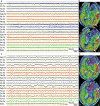Arterial spin labeling perfusion MRI applications in drug-resistant epilepsy and epileptic emergency
- PMID: 40217550
- PMCID: PMC11960231
- DOI: 10.1186/s42494-023-00134-3
Arterial spin labeling perfusion MRI applications in drug-resistant epilepsy and epileptic emergency
Abstract
Epilepsy affects all age groups and is one of the most common and disabling neurological disorders worldwide. Drug-resistant epilepsy (DRE), status epilepticus (SE), and sudden unexpected death in epilepsy (SUDEP), which are associated with considerable healthcare costs and mortality, have always been difficult to address and become the focus of clinical research. The rapid identification of seizure onset and accurate localization of epileptic foci are crucial for the treatment and prognosis of people with DRE, SE, or near-SUDEP. However, most of the conventional neuroimaging techniques for assessing cerebral blood flow of people with epilepsy are restricted by time consumption, limited resolution, and ionizing radiation. Arterial spin labeling (ASL) is a newly powerful non-contrast magnetic resonance imaging technique that enables the quantitative evaluation of brain perfusion, characterized by its unique advantages of reproducibility and easy accessibility. Recent studies have demonstrated the potential advantages of ASL for the diagnosis and evaluation of epilepsy. Therefore, in this review, we discussed the complementary value of ASL in evaluating and characterizing the basic substrates underlying refractory epilepsy and epileptic emergencies.
Keywords: Arterial spin labeling; Cerebral blood flow; Drug-resistant epilepsy; Epileptic emergency; SUDEP; Status epilepticus.
© 2023. The Author(s).
Conflict of interest statement
Declarations. Ethics approval and consent to participate: Not applicable. Consent for publication: Not applicable. Competing interests: The authors declare that they have no competing interests.
Figures





Similar articles
-
The Imaging of Localization Related Symptomatic Epilepsies: The Value of Arterial Spin Labelling Based Magnetic Resonance Perfusion.Korean J Radiol. 2018 Sep-Oct;19(5):965-977. doi: 10.3348/kjr.2018.19.5.965. Epub 2018 Aug 6. Korean J Radiol. 2018. PMID: 30174487 Free PMC article.
-
Patient-specific detection of cerebral blood flow alterations as assessed by arterial spin labeling in drug-resistant epileptic patients.PLoS One. 2015 May 6;10(5):e0123975. doi: 10.1371/journal.pone.0123975. eCollection 2015. PLoS One. 2015. PMID: 25946055 Free PMC article.
-
Arterial Spin Labeling Magnetic Resonance Imaging for Differentiating Acute Ischemic Stroke from Epileptic Disorders.J Stroke Cerebrovasc Dis. 2019 Jun;28(6):1684-1690. doi: 10.1016/j.jstrokecerebrovasdis.2019.02.020. Epub 2019 Mar 14. J Stroke Cerebrovasc Dis. 2019. PMID: 30878365
-
Status Epilepticus a risk factor for Sudden Unexpected Death in Epilepsy (SUDEP): A scoping review and narrative synthesis.Epilepsy Behav. 2024 Nov;160:110085. doi: 10.1016/j.yebeh.2024.110085. Epub 2024 Oct 9. Epilepsy Behav. 2024. PMID: 39388974
-
Mapping of cerebral perfusion territories using territorial arterial spin labeling: techniques and clinical application.NMR Biomed. 2013 Aug;26(8):901-12. doi: 10.1002/nbm.2836. Epub 2012 Jul 15. NMR Biomed. 2013. PMID: 22807022 Review.
Cited by
-
Enhancing the Diagnostic Utility of ASL Imaging in Temporal Lobe Epilepsy through FlowGAN: An ASL to PET Image Translation Framework.medRxiv [Preprint]. 2024 May 30:2024.05.28.24308027. doi: 10.1101/2024.05.28.24308027. medRxiv. 2024. PMID: 38853910 Free PMC article. Preprint.
References
-
- Beghi E. The Epidemiology of Epilepsy. Neuroepidemiology. 2020;54(2):185–91. - PubMed
-
- Singh G, Sander JW. The global burden of epilepsy report: Implications for low- and middle-income countries. Epilepsy Behav. 2020;105:106949. - PubMed
-
- Hauser WA. An unparalleled assessment of the global burden of epilepsy. Lancet Neurol. 2019;18(4):322–4. - PubMed
-
- Woermann FG, Vollmar C. Clinical MRI in children and adults with focal epilepsy: A critical review. Epilepsy Behav. 2009;15(1):40–9. - PubMed
-
- Dymond AM, Crandall PH. Oxygen availability and blood-flow in temporal lobes during spontaneous epileptic seizures in man. Brain Res. 1976;102(1):191–6. - PubMed
Publication types
Grants and funding
LinkOut - more resources
Full Text Sources
